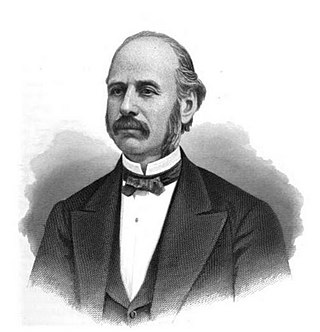
Amasa Stone, Jr. was an American industrialist who is best remembered for having created a regional railroad empire centered in the U.S. state of Ohio from 1860 to 1883. He gained fame in New England in the 1840s for building hundreds of bridges, most of them Howe truss bridges. After moving into railroad construction in 1848, Stone moved to Cleveland, Ohio, in 1850. Within four years he was a director of the Cleveland, Columbus and Cincinnati Railroad and the Cleveland, Painesville and Ashtabula Railroad. The latter merged with the Lake Shore and Michigan Southern Railway, of which Stone was appointed director. Stone was also a director or president of numerous railroads in Ohio, New York, Pennsylvania, Indiana, Illinois, Iowa, and Michigan.

The George W. Loomer House is a private residence located at 71 West Hancock Street in Midtown Detroit, Michigan. It was listed on the National Register of Historic Places in 1994.

The Cass Community United Methodist Church is located at 3901 Cass Avenue in Midtown Detroit, Michigan. It was built in 1883 as the Cass Avenue Methodist Episcopal Church, listed on the National Register of Historic Places in 1982, and designated a Michigan State Historic Site in 1985.
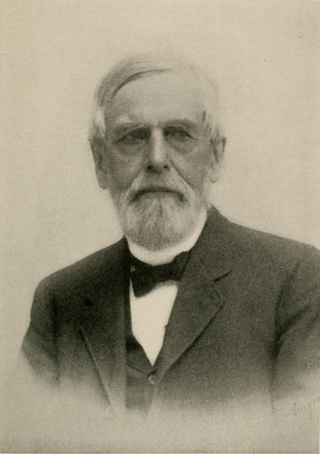
William A. Atwood was a Michigan politician.

The Calumet and Hecla Industrial District is a historic district located in Calumet, Michigan and roughly bounded by Hecla & Torch Lake Railroad tracks, Calumet Avenue, Mine and Depot Streets. The district contains structures associated with the copper mines worked by the Calumet and Hecla Mining Company, located along a line above the copper lode, where railroad tracks connected separate mine heads. The Historic District is completely contained in the Calumet Historic District and the Keweenaw National Historical Park. It was designated a Michigan State Historic Site in 1973 and was listed on the National Register of Historic Places in 1974.
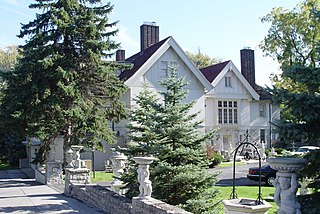
The John Thompson Woodhouse House is a private house located at 33 Old Brook Ln. in Grosse Pointe Farms, Michigan. It was listed on the National Register of Historic Places in 2005.
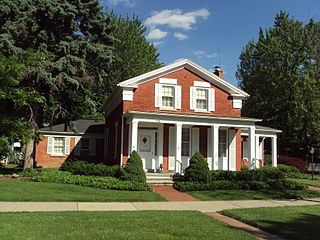
The Governor Charles Croswell House is a building located at 228 North Broad Street in the city of Adrian in Lenawee County, Michigan, United States. It was designated as a Michigan State Historic Site on February 19, 1958 and later listed on the National Register of Historic Places on March 16, 1972. It is located very close to but is not part of the Downtown Adrian Commercial Historic District.

The Ransom B. Shelden House is a private house located at 1304 College Avenue in Houghton, Michigan. It is currently used as the Tau Kappa Epsilon (ΤΚΕ) Fraternity House. The house was listed on the National Register of Historic Places in 1980.

The Central Methodist Episcopal Church is a historic church located at 215 North Capitol Avenue in Lansing, Michigan. It was listed on the National Register of Historic Places in 1980.
Brownsville, also known as Avalon, Esther's Place, and Anderson's Place, is an unincorporated community in Lawrence County, South Dakota, United States. The town was originally a lumber camp, and it was named for contractor David Brown. It is the nearest community to John Hill Ranch-Keltomaki, which is listed on the U.S. National Register of Historic Places.

The Richard C. Burtis House or Wedding Cake House is a Historic Site in Tuscola County, Michigan. The two-story Second Empire building was built from 1879 to 1880 for Richard C. Burtis, a shoemaker and local landowner. Ornamentation includes brackets and a decorative frieze supporting a mansard roof with decorative slate shingle. A bay window topped by a steep octagonal tower dominates the front facade. The Burtis home appeared on Travel Channel in 2019.

The Alma Downtown Historic District is a commercial historic district in Alma, Michigan, roughly located along Superior Street between the Pine River and Prospect Avenue, and along State Street between Center and Downie Streets. Parts of the district were designated a Michigan State Historic Site in 1975, and the entirety was listed on the National Register of Historic Places in 2013. It contains 72 structures, primarily brick commercial buildings, ranging from one to three stories in height and dating from 1874 to the 1960s.

The Iron Mountain Central Historic District is a historic district, broadly located between Fleshiem and C Streets and between Iron Mountain and Stockbridge Avenues in Iron Mountain, Michigan. The district covers the city's central business district and adjacent areas. It is primarily commercial, but also contains the historic county courthouse complex, and school, library, and church buildings. It was listed on the National Register of Historic Places in 2013.
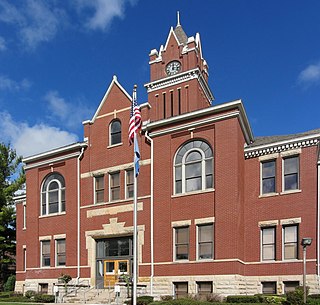
The Antrim County Courthouse is a government building located on South Cayuga Street in Bellaire, Michigan (U.S.). It was designated a Michigan State Historic Site in 1974 and listed on the National Register of Historic Places in 1980. It was designed in 1879, but construction did not begin until 1904. As of 2014, it houses the Antrim County courts and prosecuting attorney.

The Lanphere-Pratt House, also known as the Pratt-Morency House, is a private house located at 90 Division Street in Coldwater, Michigan. It was listed on the National Register of Historic Places in 1990.
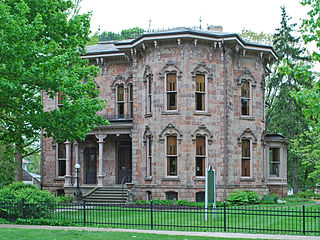
The John C. Blanchard House was built as a private house located at 253 East Main Street in Ionia, Michigan. It was listed on the National Register of Historic Places in 1974. As of 2018, it serves as the museum for the Ionia County Historical Society.

The William H. Davenport House, also known as the Davenport-Curtis House, is a single-family home located at 300 East Michigan Avenue in Saline, Michigan. It was listed on the National Register of Historic Places in 1975.

The Michigan Millers Mutual Fire Insurance Company Building is a historic office block located at 120-122 West Ottawa Street in Lansing, Michigan. It was listed on the National Register of Historic Places in 1980.

The Darius B. Moon House is a private home constructed by architect Darius B. Moon for his own use. It is located at 216 Huron Street in Lansing, Michigan. The house was listed on the National Register of Historic Places in 1982.
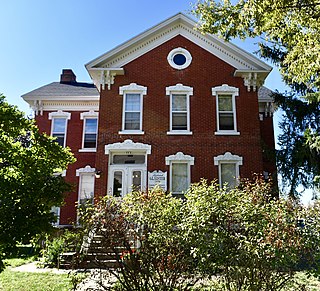
The Richard and Deborah (Brough) Glaister House is a single-family home located at 402 South Walnut Street in Lansing, Michigan. It was listed on the National Register of Historic Places in 2017.





















